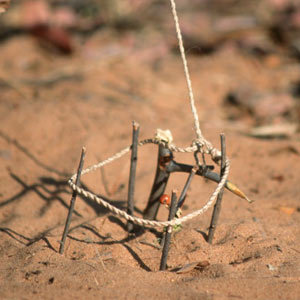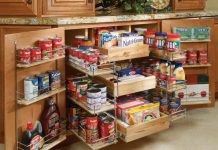The world of wilderness survival is often dominated by one method for when it comes to meat procurement. That is the rifle. While highly effective it is not the figure four deadfall that every outdoorsman turns to for food. There are people who shout the use of arrows or slingshots but for the average person, the .22 rifle is going to take the cake. This is for good reason. In the short term, there may be no better tool for gathering food.
Of course, in the long term, those rifle rounds are going to run out. When this happens, you will basically have a blunt object that can be used to bludgeon. You are not going to make rifle rounds from raw materials.
While the removal of the .22 rifle from your survival pack would not be the best advice, there is something you need to consider adding. Well, it could be several things in fact. They would all be centered around trapping. If you know how to trap and have a few items that can help you achieve this, it will change the way you survive.
We will explore how we can add traps to your setup without adding too much weight. This way you can save those bullets and keep putting meat on the table.
Related: How to Recognize Key Characteristics Of The Animal You’re Hunting
The D-4 Deadfall Trap by Self-Reliance Outfitters
Everything about the deadfall has had changed since the DF-4 Deadfall Trap has come into the picture. Since its inception, figure four deadfall has been a tremendous way to catch food by creating a trigger that would drop a hefty log or rock onto the small game. The limitations of figure four deadfall trap have always been the mastery of creating the trigger. There is also the issue of your weight having to be three times the size of the animal you wish to trap, in order to kill it.
The DF-4 Deadfall Trap by Self-Reliance Outfitters is a tremendous tool that allows you to set a deadfall faster and with more weight to bear. Each trap weighs 3.4 ounces and is made of 6000 series aluminum and assembled with aircraft-type rivets. This makes it durable and incredibly lightweight.


Great Trapping Books to Keep Handy
While there are many types of traps and tools in the trapping game. You should also call on great volumes to help you learn, not only about building traps, about the other important aspects of trapping. Things like animal behavior and trap placement are more important than the type of trap you choose. You can build the best trap ever made but if you place it in an area where animals will easily discern it or an area where animals do not frequent than what’s the point?
The Complete Book of Trapping is one of the better books out there. It may look a little dated but it will give you an in-depth look at trapping and the nuances that go into it.
The Trapper’s Bible is another staple of the trappers library. This is easily the most comprehensive trapping guide on the market.
Camp Life in the Woods and the Tricks of Trapping and Trap Making is a paperback volume that just cries out to be carried. I always like to have a book that carries well. I can slip these down in a bugout bag or a camping bag and have tremendous knowledge at my fingertips.
The Gig
While not a trap itself the gig is an incredible tool if you are attempting to procure food in the wild. What most people don’t realize is how easily your gig can be tied to or attached to a trap. The four spiked gig often has small barbs on it to assure the prey cannot easily slide off the points. This can have incredible benefits if you can adapt it to the trap you are using.
Not to mention, the gig is a great way to simply spearfish and frogs for food while you wait for your traps to fill up.
Related: Healthy Habits For Outdoor Survival
Practice Trapping to Perfect the Techniques
Trapping from a distance is way better than trapping up close. It’s not a pretty thing to witness. If you are used to getting meat that is packed in Styrofoam containers and cellophane wrap. You may return to a trap and find that your food is still alive (something that the trapper must, unfortunately, take care of).


All of this combined makes an up a situation that can often be terrible for someone without experience. You don’t want your first trapped meal to be a live groundhog that you need to dispatch.
Also, you want to have some failures under your belt, as well. Your first trapping experience should not be when you need food the most. By taking the time to trap a few animals, you don’t have to become a fur trader, but having the experience will help you to quickly become a more formidable trapper.
Look up the trapping regulations in your local wildlife management department and start your journey there. Whether you know it or not there are public lands that offer trapping opportunities. You will need to adhere to their rules and only trap the animals they allow when the season is right.
Give Trapping a Chance!
This article was not written to dissuade you from using projectiles to procure food in a survival situation. The modern firearm is the most effective weapon for the average person to own and use. Side by side it will outperform a trap because of the distance and durability of the weapon. Still, projectile firing weapons require projectiles and in the wild, that can be a problem. Even carving cedar arrows can be tedious, assuming you can pull that off at all.
This article is much more about the addition of trapping to your skill set (also check out How to Make Snare Traps here). It’s also about not getting hung up and big-headed about your gun. Some people can put everything on a firearm and if that fails or if they do run out of bullets, they are left scrambling.
Happy Prepping!





















